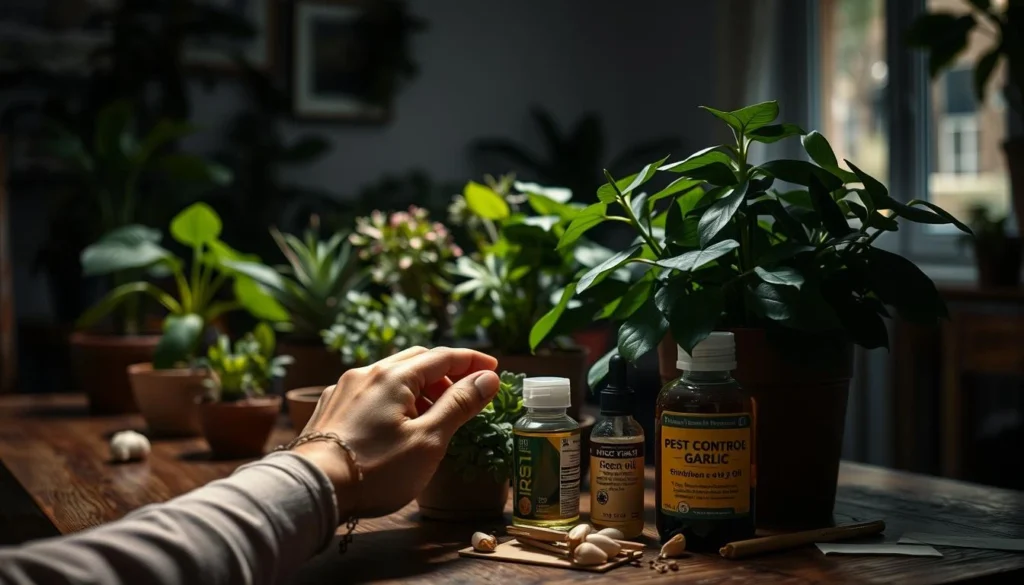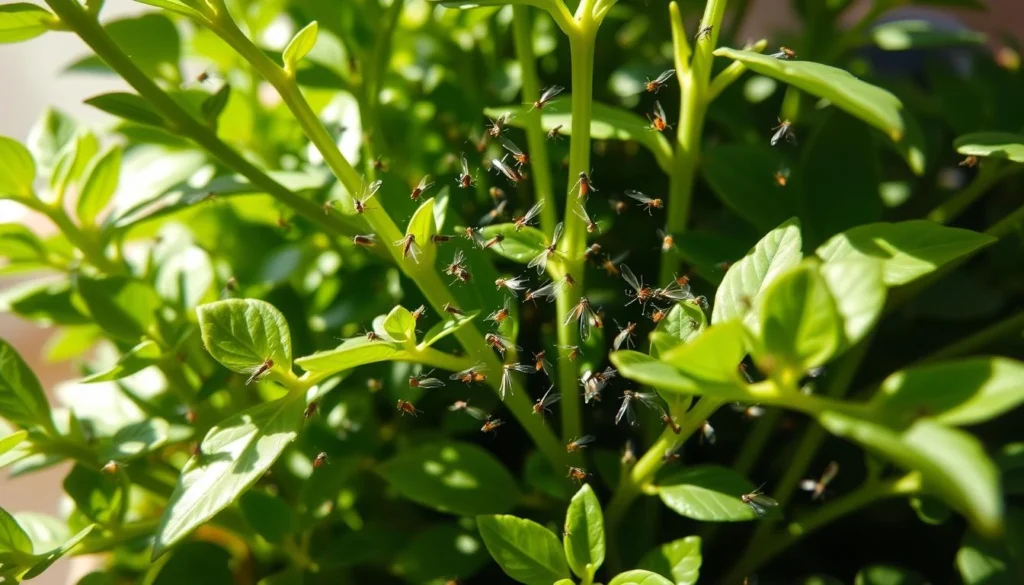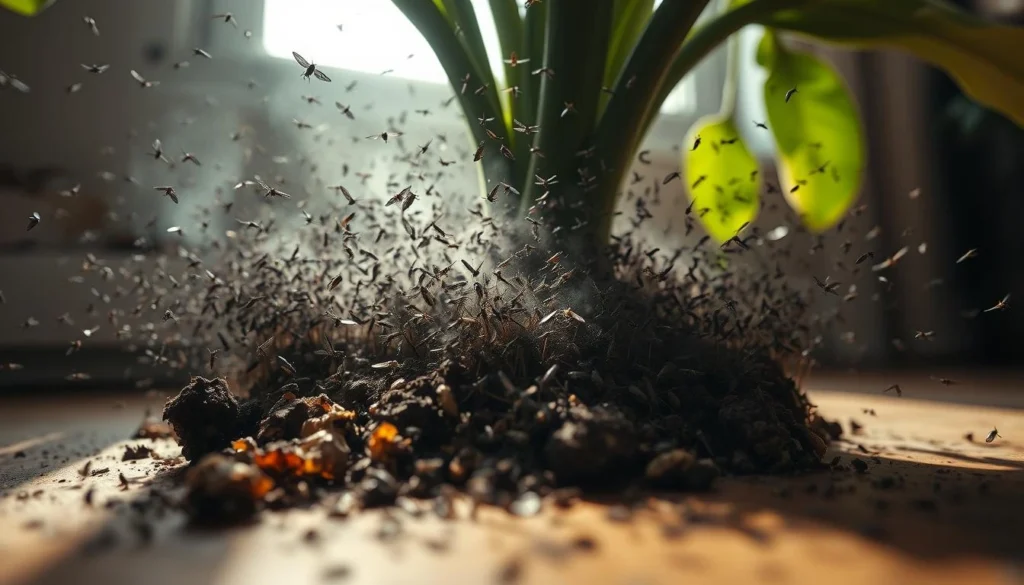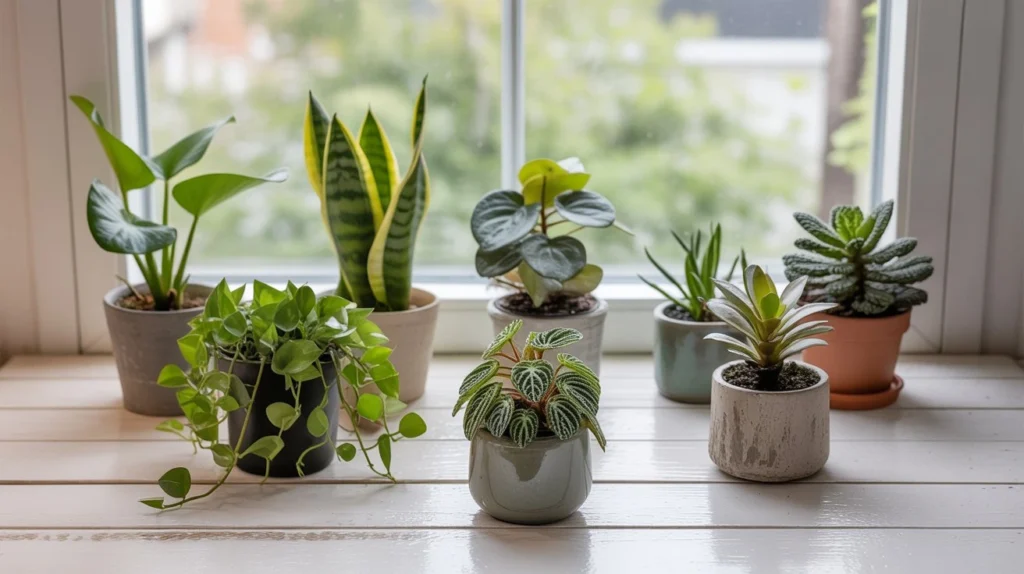
Did you know fungus gnats can lay up to 200 eggs at a time in your indoor plants? These tiny pests can quickly become a nuisance, causing annoyance and potentially harming your plants.
Fungus gnats are attracted to the moist soil of indoor plants, where they feed on fungi and plant roots. If left unchecked, they can cause significant damage to your plants, leading to poor growth and health issues.
In this article, we’ll explore effective tips and tricks for eliminating gnats and other common pests that affect indoor plants. You’ll learn how to identify the signs of infestation, prevent future occurrences, and keep your plants healthy and thriving.
Table of Contents
Understanding Gnats Indoor Plants
To deal with gnats in your indoor plants, knowing what they are and how they spread is key. Fungus gnats are tiny flying bugs that love moist places. Your indoor plants are a great spot for them to breed.
What Are Fungus Gnats?
Fungus gnats are small, delicate insects that are usually gray or black. They are drawn to fungi and algae in wet potting soil. Adult gnats are not harmful, but their larvae can harm your plants a lot.

Why Gnats Are Attracted to Your Houseplants
Gnats like the moist soil of your houseplants because it’s perfect for their eggs and larvae. If you water your plants too much, it can make a gnat problem worse.
The Life Cycle of Fungus Gnats
The life cycle of fungus gnats has four stages: egg, larva, pupa, and adult. Knowing this cycle is important for controlling gnats. It helps you focus on the most critical stages of their growth.
Identifying a Gnat Infestation in Your Houseplants
Spotting gnats in your indoor plants is the first step to get rid of them. You need to know what signs to look for.
Common Signs of Gnat Problems
Signs of gnats include seeing adult gnats flying around your plants. You might also find larvae in the soil. Yellowing or wilting leaves can also be a sign of gnat larvae damage.
- Adult gnats flying around plants
- Larvae in the soil
- Yellowing or wilting leaves
Differentiating Gnats from Other Indoor Plant Pests
Gnats are often confused with fruit flies or mosquitoes. But gnats are smaller and more delicate. Look for their long, thin legs and wings to confirm an infestation.

When to Take Action
If you see any signs of gnats, act fast. Early intervention stops the infestation from getting worse and harming your plants.
Why Gnats Are Harmful to Your Indoor Plants
Gnats might seem like a small problem, but they can really hurt your indoor plants. Their young ones eat the roots, which can slow down growth and cause other issues.
Damage to Plant Roots and Growth
Gnat larvae harm plant roots. This can make plants grow slowly, turn yellow, and become weak. It also makes it hard for plants to get water and nutrients.
Secondary Problems Caused by Gnats
Gnats can also make plants more likely to get sick or attract other pests. Using natural remedies for gnats in plants can help prevent these problems.
Health Concerns for Humans and Pets
Gnats are usually not dangerous to people, but they can bother some. Some folks might get allergic reactions from gnat bites. For pets, gnats are not a big worry, but indoor plant pest control can help keep them away.
| Problem | Effect on Plants | Solution |
|---|---|---|
| Gnat Larvae | Root Damage, Stunted Growth | Natural Remedies, Improved Soil Drainage |
| Gnat Infestation | Increased Disease Susceptibility | Indoor Plant Pest Control Measures |
Common Causes of Gnats Indoor Plants
Many things can lead to gnats in houseplants. Knowing these helps prevent them. Gnats do well in certain conditions.
Overwatering Issues
Overwatering is a primary cause of gnat infestations. When soil is always wet, gnats love it. Check soil moisture often to avoid this.
Poor Soil Quality
Soil that holds too much water attracts gnats. Use a potting mix that drains well to prevent this.
Organic Matter Decomposition
Decomposing organic matter in soil feeds gnat larvae. Remove dead plant parts to lower infestation risk.
Bringing Home Infested Plants
Bringing an infested plant into your home can spread gnats. Inspect new plants before bringing them inside.
Prevention: Stop Gnats Before They Start
Keeping gnats away from your indoor plants is key to their health. A few simple steps can greatly lower the chance of gnats showing up.
Proper Watering Techniques
Too much water can lead to gnats. Let the soil dry a bit before watering again. Check the soil’s moisture by feeling it with your finger. If it’s dry, it’s time to water.
Soil Management Strategies
Use a potting mix that drains well to avoid soggy soil. Repot your plants now and then to update the soil and get rid of gnat attractants.
Quarantine Procedures for New Plants
Before adding new plants to your space, keep them isolated for a few weeks. Look for any signs of gnats and treat them if you find any.
Environmental Controls
- Watch the temperature and humidity levels.
- Don’t over-fertilize, as it can draw gnats.
By taking these steps, you can make your indoor garden less welcoming to gnats.
Natural Remedies for Eliminating Gnats Indoor Plants
You don’t need harsh chemicals to get rid of gnats. There are many natural ways to tackle this problem. These methods are safe for your plants and the environment.
Sticky Trap Solutions
Sticky traps are a great way to control gnats. They catch adult gnats, stopping them from laying eggs. This reduces the gnat population. You can make your own sticky trap with cardboard, honey or corn syrup, and apple cider vinegar.
Cinnamon and Other Household Remedies
Cinnamon is a natural fungicide that fights fungus gnats. Sprinkling cinnamon on the soil stops gnat larvae from growing. Neem oil and apple cider vinegar can also repel or kill gnats.
DIY Gnat-Killing Sprays
Making your own gnat-killing sprays is another good option. Mix water with mild dish soap to spray on plants. Neem oil sprays are also effective against gnats.
Beneficial Nematodes and Predators
Beneficial nematodes are tiny worms that kill gnat larvae. Adding them to your soil controls gnats for a long time. Predatory mites can also help control gnat numbers.
Sand and Gravel Top Dressing
Using sand or gravel on top of your plants helps prevent gnat larvae. It improves soil drainage and reduces moisture. This makes it harder for gnats to infest your plants.
These natural remedies help get rid of gnats without using harmful chemicals. They not only control gnats but also make your plants healthier.
Commercial Products to Control Gnats in Houseplants
Commercial products offer many ways to fight gnats indoor plants. They range from insecticidal soaps to systemic insecticides. These options can help when natural methods don’t work, keeping your plants safe.
Insecticidal Soaps and Sprays
Insecticidal soaps are a soft but strong way to fight gnats. They break down the insect’s shell and dry them out. Always read the instructions and test on a small area first to protect your plants.
Hydrogen Peroxide Treatments
Hydrogen peroxide is also good for getting rid of gnats. It kills gnat larvae by releasing oxygen into the soil. Mix it with water as the product says and water your plants with it.
Systemic Insecticides
Systemic insecticides are absorbed by the plant. They help control gnats that feed on the plant’s sap. But, they can harm good insects, so use them carefully and follow the instructions.
Mosquito Bits and Dunks
Mosquito bits and dunks contain a bacterium that kills gnat larvae. They are safe and effective for controlling gnats in standing water and moist soil.
When to Use Chemical Controls
Use chemical controls only when other methods fail or the infestation is bad. Always follow the product’s instructions and take precautions to avoid exposure.
Read More :
Effective Tips to Control Aphids on Indoor Plants
Conclusion: Maintaining Gnat-Free Indoor Plants
To keep indoor plants free from gnats, you must stay alert and care for them well. Knowing why gnats show up and how to stop them is key. Use the right watering, manage soil, and quarantine new plants to avoid gnats.
Check your plants often and act fast if you see gnats. Mix these steps with natural or store-bought solutions to get rid of gnats. This way, you can enjoy gardening indoors without pests.
Be active in your gardening, and you’ll keep gnats away. Your plants will stay healthy and add beauty to your home.
FAQ
What are fungus gnats and why are they attracted to my indoor plants?
Fungus gnats are tiny flying insects that love moist environments. They feed on fungi, algae, and plant roots. This makes your houseplants a perfect place for them to breed.
How do I know if I have a gnat infestation in my houseplants?
Look for tiny flying insects, yellowing leaves, and wilting plants. Also, check for eggs or larvae in the soil.
Can gnats harm my plants and are they a health risk to humans and pets?
Yes, gnats can harm your plants by eating their roots. This can cause stunted growth and yellow leaves. While gnats aren’t a direct health risk, they can be a nuisance.
What causes gnat infestations in indoor plants, and how can I prevent them?
Overwatering, poor soil, and infested plants can cause gnats. To prevent them, water correctly, use good soil, and quarantine new plants.
Are there any natural remedies to get rid of gnats in my indoor plants?
Yes, you can use sticky traps, cinnamon, DIY sprays, and beneficial nematodes. You can also use sand or gravel to repel gnats. These methods are safe and effective.
What commercial products are available to control gnats in houseplants?
You can use insecticidal soaps, hydrogen peroxide, and systemic insecticides. Mosquito bits or dunks also work. Always follow instructions and be careful.
How can I maintain gnat-free indoor plants?
Keep your plants watered right, check them often, and act fast if you see gnats. Regular checks and natural remedies can keep your plants healthy and gnat-free.
Can I use neem oil to control gnats in my indoor plants?
Yes, neem oil is a natural way to fight gnats. Mix it with water as directed and spray it on your plants and soil.
How often should I inspect my indoor plants for gnats?
Check your plants once a week for gnats. Look for flying insects, eggs, or larvae. Act quickly if you find any.

